There are 11 species of snakes in New Hampshire and only one is venomous: the Timber Rattlesnake, which is protected by state law.
This means you cannot legally kill a Timber Rattlesnake and if you run into one, you should alert authorities once and for all so that they can have it taken care of for you.
New Hampshire’s Wildlife Action Plan identified several snake species by the amount of need for conservation. They deemed the Timber Rattlesnake, Smooth Green Snake, Northern Black Racer, and Ribbonsnake as endangered or at risk of endangerment by the state.
You cannot own non-venomous reptiles as pets, as it is deemed unlawful unless you are exhibitors by the state of New Hampshire.
While it is important to know the laws for owning snakes in New Hampshire, it’s also good to know what types of snakes you can find in the state. Here is our list:
Table of Contents
Snakes in New Hampshire
Here are some common snakes that roam the state:
1. Common Gartersnake
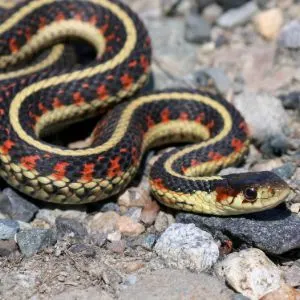
- Experience Level: Beginner
- Family: Colubridae
- Scientific Name: Thamnophis sirtalis
- Other Names: Garter Snake
- Adult Size: 23 to 30 inches; some can grow up to 5 feet
- Lifespan: 4 to 5 years in the wild; up to 10 years in captivity
Common Garter Snakes are completely harmless to humans.
These guys are usually relatively small and like to remain active during the day. These guys like to soak often, so they will require a bowl in their tank for them to soak in, especially when it comes time to shed.
Garter snakes are great snakes for beginners since they are docile and will not grow to be too large.
Common Garter Snakes can range from dark olive-green to brown or black with a distinctive yellow stripe running throughout the length of their body.
When threatened, they may let off a musk in order to ward off predators. They can be found in many places like marshes, woodlands, meadows, or hillsides.
These snakes feed on leeches, slugs, worms, small fish, amphibians, and even other snakes. They are also immune to toxic frogs that secrete toxins from their skin in order to drive away prey.
2. Milksnake
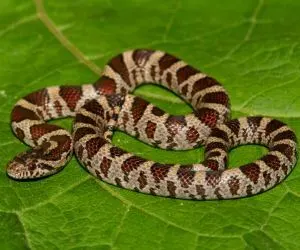
- Experience Level: Beginner
- Family: Colubridae
- Scientific Name: Lampropeltis triangulum
- Other Names: Milk Snake
- Adult Size: About 4 feet
- Lifespan: 22 years
Milk Snakes are a species of Kingsnake that are non-venomous, friendly, docile, and beautiful to look at.
Milksnakes are tan or brown with black-brown bands and blotches that loop around the length of their body. Their skin can sometimes be a pale yellow with almost a red striped pattern, similar to the Western Milk Snake and the venomous Coral snake or a Rattlesnake, depending on the Milk Snake.
They have cat-like pupils that can look intimidating but lack the rattle at the end of their tails.
They can be found in meadows, pastures, under any artificial cover, by the edges of watercourses, by mountain cliffs, and woodlands. These carnivorous snakes feed on lizards, reptile eggs, birds and their eggs, mice, and sometimes insects.
3. Ribbon Snake
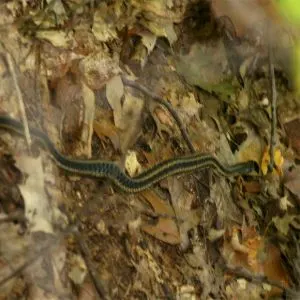
- Experience Level: Beginner
- Family: Colubridae
- Scientific Name: Thamnophis sauritus
- Other Names: Ribbonsnake
- Adult Size: 16 to 35 inches
- Lifespan: 10+ years in captivity; wild lifespan unknown
Ribbonsnakes are the most common species of Garter Snakes there are. These shy, non-poisonous snakes make popular pets due to their many morph options and the fact that they are not dangerous to keep.
These snakes are the best-tempered out of all the subspecies of Ribbonsnakes and can make good pets for novice snake keepers when bought from a reputable pet store where they are captive-bred, of course.
Ribbonsnakes are usually slender-bodied, tan or dark brown with prominent light-colored stripes throughout their length which is usually a bright or pale yellow.
They are semi-aquatic creatures and can be found mostly near a water source like the shorelines of rivers or lakes. They will sometimes inhabit water edges near forests or wetlands.
They are carnivorous and feed on small fish, insects, and tadpoles.
4. Northern Watersnake
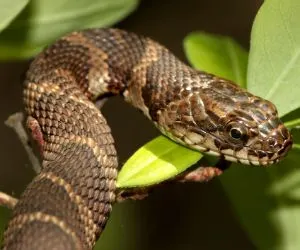
- Experience Level: Beginner
- Family: Colubridae
- Scientific Name: Nerodia sipedon
- Other Names: Water Snake, Watersnake
- Adult Size: 24 to 55 inches
- Lifespan: 9 years
Northern Water Snakes are popular pets since they do not require much effort and are relatively safe, even around children. They can also grow fairly large in size.
They are usually dark in color, ranging from brown, tan, to gray, and have keeled scales. They also have square blotches on their backs and sides that may alternate or become bands throughout their length.
Water Snakes typically live in or near aquatic habitats which is why they are called water snakes. They like to bask on rocks by still or slow-moving water such as seasonal pools, lakes, and ponds.
You might see them swimming and hunting the waters as well.
They like to eat fish and amphibians, swallowing them whole and alive. They eat all kinds of fish species such as smallmouth bass, minnows, bullhead catfish, hogsuckers, sunfish, and brook trout.
5. Eastern Hog-nosed Snake
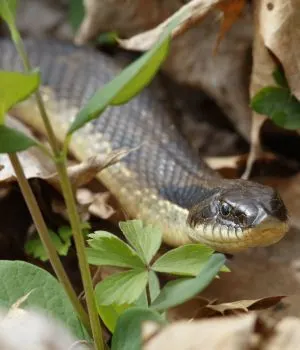
- Experience Level: Beginner
- Family: Colubridae
- Scientific Name: Heterodon platirhinos
- Other Names: Eastern Hognosed snake, Eastern Hognose
- Adult Size: 20 to 33 inches
- Lifespan: 12 years
The Hognose snake is known to be one of the best pet snakes for enthusiasts since they are not fussy and are comfortable with human interaction. They also stay relatively small.
These worm-like snakes have a large, round head with an upward-facing snout, which is what we all love about them. They are dark gray or olive-green, but some are also yellow, tan, or light brown with dark brown spotted patterns on their head and sometimes their bodies.
They prefer to inhabit sandy woodlands, farmland, coastal areas, and fields where they feed on frogs, salamanders, invertebrates, birds, and small mammals. They can use their hog-like nose to get into their prey’s burrows more easily.
6. Ringneck Snake
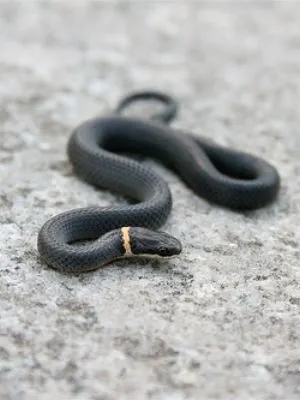
- Experience Level: Intermediate
- Family: Colubridae
- Scientific Name: Diadophis punctatus edwardsii
- Other Names: Northern Ring-necked Snake
- Adult Size: 10 to 15 inches
- Lifespan: 10 to 20 years in the wild; 6 years in captivity
While you can keep these small snakes as pets, they do not usually do too well in captivity due to their timid nature and difficulties when breeding. All subspecies of the Ringneck snakes are threatened in their native habitats and should not be captured.
Ringneck Snakes are not the easiest to take care of since they have specific needs in order to stay alive. They also don’t make the best pets since they want to remain hidden at all times.
A lot of Ringnecks will be captured and taken from their habitats into the hands of overzealous first-time keepers. Usually, they will refuse to eat after a week or two in captivity.
However, they respond to handling quite well since they are not aggressive. Even though they are slightly venomous, their poison is comparable to that of a bee’s sting.
Ringnecks’ well-known defense mechanism is the curling up of their tail, which shows off their bright red underside and happens when they are feeling threatened. While they are non-aggressive, they may try to nip at you, but even that will be hard to do since they have rear-facing fangs.
They pose very little threat to humans who want to handle them but do not enjoy being seen and like to remain hidden.
Northern Ringneck Snakes have a flat, black head with smooth scales all throughout their thin body, which is usually dark gray or a dull blue-gray in color. Their undersides may be a bright or pale yellow sometimes with small speckles or spots.
They get their name from the yellow or orange band that circles their neck. There are many subspecies that might vary in color.
They are sometimes mistaken to be Prairie Ringnecks since they are similar in size as well as color. You can differentiate them by looking at their undersides since a Northern Ringsnake will have a solid pale yellow belly without any markings.
These tiny snakes don’t like to be seen or out in the open so they like to inhabit areas like moist forests or dry deciduous forests. In these habitats, you can find them feasting on earthworms, smaller snakes, salamanders, small amphibians, and beetles.
7. Dekay’s Brownsnake
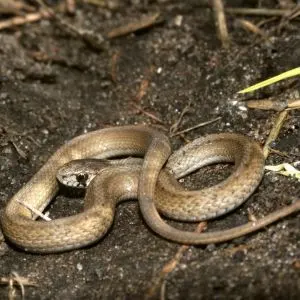
- Experience Level: Beginner
- Family: Colubridae
- Scientific Name: Storeria dekayi
- Other Names: Brown Snake, DeKay’s Brown Snake
- Adult Size: approximately 13 inches
- Lifespan: 7 years in captivity; unknown in the wild
Brownsnakes are not shy and humans commonly encounter them. They can make great pets for beginners due to their size and gentle nature. They are also quite easy to feed.
These non-venomous snakes are usually brown in color, as their name suggests, but can also come in a yellowish, red, or grayish-brown tone.
They will typically have two rows of either darker or lighter spots which might also be linked, making it look like a collar or middorsal streak down the side of their head. Underneath each of their eyes may also be a small, dark spot.
These markings may also not appear on some individuals.
Their undersides will either be white or tan.
They like to reside in various woodlands, more commonly in wet areas like swamp edges or wetland borders. They like to roam the litters of abandoned fields, lowland hardwoods, prairies, and oak savannas.
They are also often spotted in residential areas or urbanized territories.
In their habitats, they will consume small invertebrates like earthworms, slugs, and snails with their specialized jaws and teeth. They may also eat beetles and salamanders if they come across one.
8. Smooth Green Snake
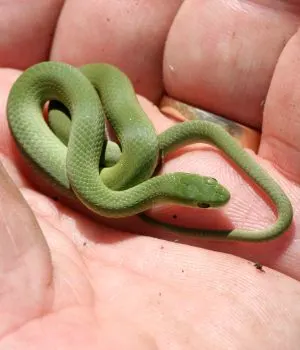
- Experience Level: Intermediate
- Family: Colubridae
- Scientific Name: Opheodrys vernalis
- Other Names: Green Snake, Smooth Greensnake
- Adult Size: 14 to 20 inches
- Lifespan: 6 years
While you can find these snakes out in the wilderness, they are rarely encountered due to their timid nature.
Smooth Green snakes can make great pets for any owner that is a little squeamish about feeding them dead rodents. These guys will mostly eat insects like spiders, moths, ants, snails, slugs, worms, and spineless caterpillars.
However, it is said that they do not make great pets since they are way too timid for human interaction. However, they are harmless and some enjoy being handled.
They can be found in open woods, stream edges, marshes, and meadows. They thrive in moist, grassy areas.
As you can already tell by their name, these snakes will be a bright green, which can range in shade. They stay relatively small and may have a pale yellow underside with beady eyes.
These are not the easiest snakes to keep captive since they are very anxious and easily stressed out.
9. North American Racer
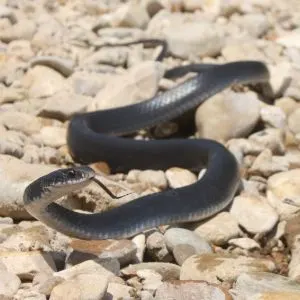
- Experience Level: Intermediate
- Family: Colubridae
- Scientific Name: Coluber constrictor
- Other Names: Black Racer, Racer, North American Blue Racer
- Adult Size: Anywhere from 20 to 65 inches
- Lifespan: 10 years
These slender snakes are versatile and are not dangerous or venomous. They are called racers because they are very fast-moving.
They are mostly docile creatures. However, if they feel threatened, they are ready to defend themselves. In most cases, it can be quite hard for these snakes to become accustomed to handling.
These snakes are silvery-grey and can sometimes be an almost metallic-looking electric blue. North American Racers will have a pale yellow or white underside and a black tongue.
A bite from them is shocking but harmless to humans or larger pets like dogs or cats.
They inhabit young or regrowing forest edges and shrubland. These Racers feed on small mammals, insects, smaller snakes, and lizards by swallowing them alive.
10. Red-bellied Snake
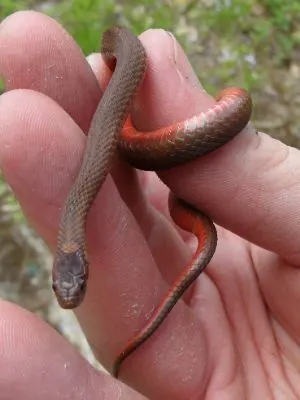
- Experience Level: Intermediate
- Family: Colubridae
- Scientific Name: Storeria occipitomaculata
- Other Names: Redbelly snake, Red-belly Snake, Copperbelly Snake, Northern Red-bellied Snake
- Adult Size: 8 to 16 inches
- Lifespan: 4 years in captivity; Wild lifespan unknown but predicted to be longer than in captivity
While Red-bellied Snakes are rarely encountered in the state, they still exist in the wilderness. They are just very secretive.
These small snakes can be found in swarms basking in the sun on the warm days of September to October. You can also find them in woodlands, fields, under logs, in forests, bike trails, back roads, and sphagnum bogs.
In these areas, they feed on earthworms, beetle larvae, and slugs.
People can sometimes find them out in their pesticide-free garden or just out in the wild and might want to keep them as a pet. However, they really struggle to eat when in captivity and will sometimes just outright refuse when they are removed from the wild.
They do not do well in captivity and prefer to be free to roam the lands as they please. Although they aren’t hard to obtain in the wild, they might not be the best pet to keep if you are planning to have them for long since they do not do well away from their natural habitat.
Due to this, you might not run into them as often in the wild since they like to stick to their spaces. They are not as tolerant of populated areas.
It’s not hard to identify these snakes since they really do live up to their name with their flashy red or orange undersides. Their bodies might be a dark steel grey, black with a blue tint, or copper brown. Some may also have two dark stripes along their sides or a thick, light-colored band down the middle of their backs.
While they will usually first curl their tails or flee in defense before they try to bite, their little nibble probably won’t affect you anyway.
While they are small and beautiful, this does not mean they will make a good pet since they do not usually survive long in captivity.
Venomous Snake Species in New Hampshire
Here is a list of the most venomous snakes that roam the state:
11. Timber Rattlesnake
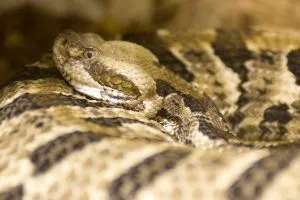
- Experience Level: Expert
- Family: Viperidae
- Scientific Name: Crotalus horridus
- Other Names: Canebrake Rattlesnake, Banded Rattlesnake
- Adult Size: 6 feet
- Lifespan: Anywhere from 10 to 30 years in the wild; 30+ years in captivity
Rattlesnake bites are very serious and should be treated as a medical emergency. However, they are also somewhat timid creatures, meaning they are not often spotted.
These vipers are usually gray or yellow-brown in color with dark brown blotches all or bands throughout their body and a brown, yellow, or copper stripe running down the length of their back.
They can generally be found in bluffs, croplands, rugged deciduous forest terrains, rocky ledges, and dense woodlands with closed canopies. They like to move around during different seasons and females will move to rocky terrains when they are pregnant for higher temperatures.
Timber Rattlesnakes feed mainly on smaller mammals but will also eat the occasional bird if they feel like it.
Conclusion
Whether you are a New Hampshire resident or are, for whatever reason, interested in learning what snake species are available in the area, we hope that this article did you justice.
While there are few species available in the state, they still add to the interesting wildlife. Whether you are visiting or live there, watch out for the Timber Rattler!
Let us know in the comment section down below about your experiences with owning a snake if you are from the state of New Hampshire.
Snakes in other states
References
https://www.wildlife.state.nh.us/nongame/snakes.html
https://www.wildlife.state.nh.us/nongame/rules-amp-rept.html
